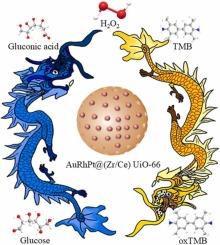Multi-metal nanozyme loaded (Zr/Ce) UiO-66 driven self-cascade catalysis nanoreactor based on split aptamer for sensitive detection of pathogenic bacteria
IF 3.7
1区 化学
Q1 CHEMISTRY, ANALYTICAL
引用次数: 0
Abstract
Pathogenic bacteria pose a significant impact on human and environmental health. Therefore, establishing a rapid and sensitive method for detecting these bacteria is urgent. In this study, a self-cascade catalysis nanoreactor based on split aptamers (SPA) was developed for the sensitive detection of E. coli O157:H7, enabling a self-powered H2O2 strategy and improved convenience. This approach employed (Zr/Ce) UiO-66 anchored with an AuRhPt trimetallic nanozyme. The incorporation of Ce enhances the specific surface area and catalytic activity of Zr UiO-66. The AuRhPt@(Zr/Ce) UiO-66 nanozyme exhibits multiple catalytic activities, such as glucose oxidase (GOx) and peroxidase (POD) activities, enabling the development of a self-powered H2O2 strategy. Subsequently, the aptamer was split into two shorter fragments to minimize steric hindrance, reduce costs, and achieve high performance. A self-cascade catalysis nanoreactor was developed using a split aptamer recognition and assembly strategy for the rapid and sensitive detection of E. coli O157:H7 in different real samples. The linear range for E. coli O157:H7 was 101–105 CFU/mL in lake water, lettuce, and milk samples, with a limit of detection (LOD) of 101 CFU/mL and recoveries ranging from 81% to 117%. Consequently, this self-cascade catalysis nanoreactor is well-suited to the sophisticated detection requirements of diverse samples and shows significant promise as a highly sensitive and efficient approach for identifying other targets.

基于分裂适体的多金属纳米酶负载(Zr/Ce) UiO-66驱动自级联催化纳米反应器用于病原菌的灵敏检测
致病菌对人类和环境健康造成重大影响。因此,建立一种快速灵敏的检测这些细菌的方法迫在眉睫。本研究开发了一种基于分裂适体(SPA)的自级联催化纳米反应器,用于大肠杆菌O157:H7的灵敏检测,实现了自供电H2O2策略,提高了便利性。该方法采用(Zr/Ce) UiO-66锚定的AuRhPt三金属纳米酶。Ce的掺入提高了Zr UiO-66的比表面积和催化活性。AuRhPt@(Zr/Ce) UiO-66纳米酶具有多种催化活性,如葡萄糖氧化酶(GOx)和过氧化物酶(POD)活性,从而实现自供电H2O2策略的开发。随后,将适配体分成两个较短的片段,以最小化位阻,降低成本并实现高性能。采用分离适配体识别和组装策略,构建了一种自级联催化纳米反应器,用于快速灵敏地检测不同样品中的大肠杆菌O157:H7。在湖水、生菜和牛奶样品中,大肠杆菌O157:H7的检出限为101 ~ 105 CFU/mL,检出限为101 CFU/mL,回收率为81% ~ 117%。因此,这种自级联催化纳米反应器非常适合各种样品的复杂检测要求,并且作为一种高度敏感和高效的识别其他目标的方法显示出巨大的希望。
本文章由计算机程序翻译,如有差异,请以英文原文为准。
求助全文
约1分钟内获得全文
求助全文
来源期刊

Sensors and Actuators B: Chemical
工程技术-电化学
CiteScore
14.60
自引率
11.90%
发文量
1776
审稿时长
3.2 months
期刊介绍:
Sensors & Actuators, B: Chemical is an international journal focused on the research and development of chemical transducers. It covers chemical sensors and biosensors, chemical actuators, and analytical microsystems. The journal is interdisciplinary, aiming to publish original works showcasing substantial advancements beyond the current state of the art in these fields, with practical applicability to solving meaningful analytical problems. Review articles are accepted by invitation from an Editor of the journal.
 求助内容:
求助内容: 应助结果提醒方式:
应助结果提醒方式:


